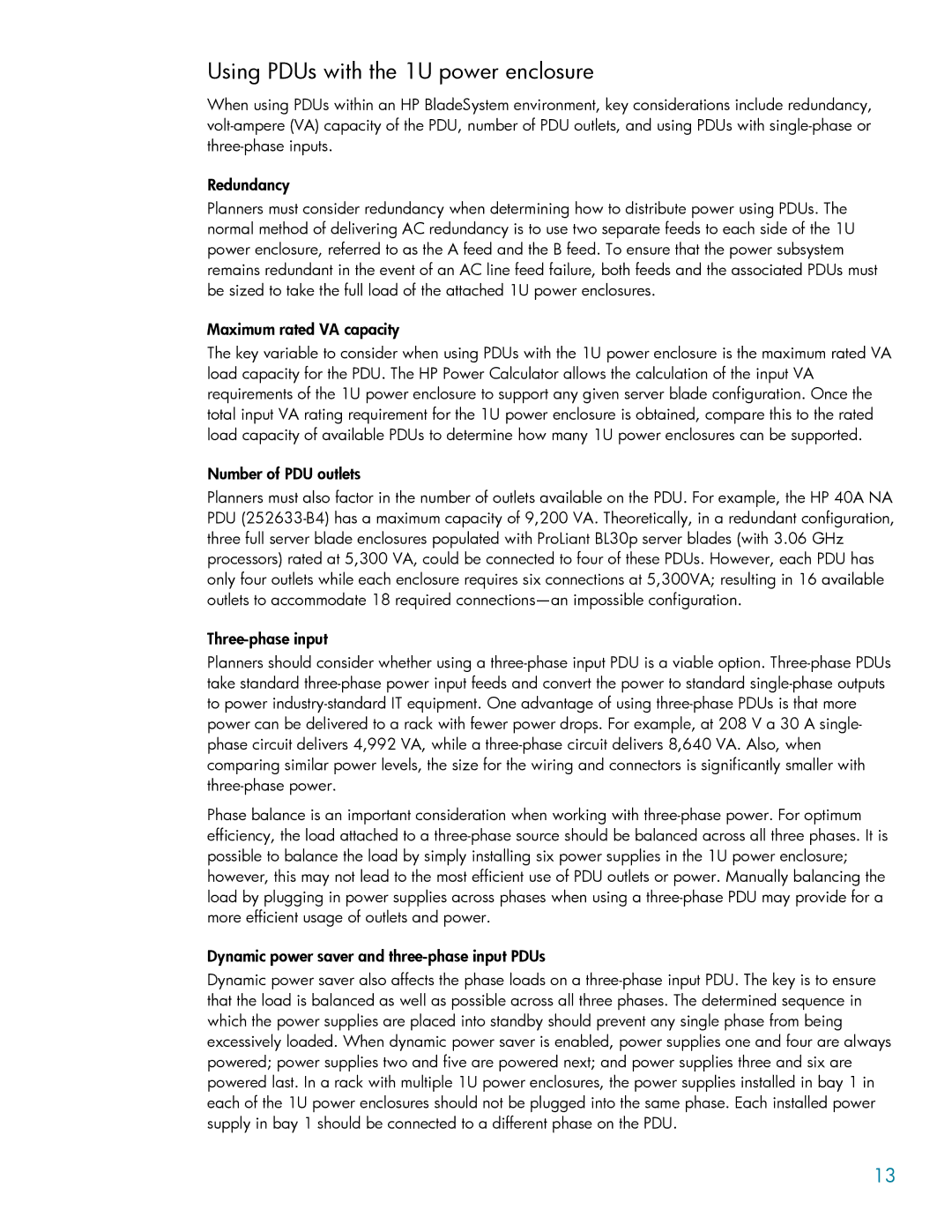Using PDUs with the 1U power enclosure
When using PDUs within an HP BladeSystem environment, key considerations include redundancy, volt-ampere (VA) capacity of the PDU, number of PDU outlets, and using PDUs with single-phase or three-phase inputs.
Redundancy
Planners must consider redundancy when determining how to distribute power using PDUs. The normal method of delivering AC redundancy is to use two separate feeds to each side of the 1U power enclosure, referred to as the A feed and the B feed. To ensure that the power subsystem remains redundant in the event of an AC line feed failure, both feeds and the associated PDUs must be sized to take the full load of the attached 1U power enclosures.
Maximum rated VA capacity
The key variable to consider when using PDUs with the 1U power enclosure is the maximum rated VA load capacity for the PDU. The HP Power Calculator allows the calculation of the input VA requirements of the 1U power enclosure to support any given server blade configuration. Once the total input VA rating requirement for the 1U power enclosure is obtained, compare this to the rated load capacity of available PDUs to determine how many 1U power enclosures can be supported.
Number of PDU outlets
Planners must also factor in the number of outlets available on the PDU. For example, the HP 40A NA PDU (252633-B4) has a maximum capacity of 9,200 VA. Theoretically, in a redundant configuration, three full server blade enclosures populated with ProLiant BL30p server blades (with 3.06 GHz processors) rated at 5,300 VA, could be connected to four of these PDUs. However, each PDU has only four outlets while each enclosure requires six connections at 5,300VA; resulting in 16 available outlets to accommodate 18 required connections—an impossible configuration.
Three-phase input
Planners should consider whether using a three-phase input PDU is a viable option. Three-phase PDUs take standard three-phase power input feeds and convert the power to standard single-phase outputs to power industry-standard IT equipment. One advantage of using three-phase PDUs is that more power can be delivered to a rack with fewer power drops. For example, at 208 V a 30 A single- phase circuit delivers 4,992 VA, while a three-phase circuit delivers 8,640 VA. Also, when comparing similar power levels, the size for the wiring and connectors is significantly smaller with three-phase power.
Phase balance is an important consideration when working with three-phase power. For optimum efficiency, the load attached to a three-phase source should be balanced across all three phases. It is possible to balance the load by simply installing six power supplies in the 1U power enclosure; however, this may not lead to the most efficient use of PDU outlets or power. Manually balancing the load by plugging in power supplies across phases when using a three-phase PDU may provide for a more efficient usage of outlets and power.
Dynamic power saver and three-phase input PDUs
Dynamic power saver also affects the phase loads on a three-phase input PDU. The key is to ensure that the load is balanced as well as possible across all three phases. The determined sequence in which the power supplies are placed into standby should prevent any single phase from being excessively loaded. When dynamic power saver is enabled, power supplies one and four are always powered; power supplies two and five are powered next; and power supplies three and six are powered last. In a rack with multiple 1U power enclosures, the power supplies installed in bay 1 in each of the 1U power enclosures should not be plugged into the same phase. Each installed power supply in bay 1 should be connected to a different phase on the PDU.
